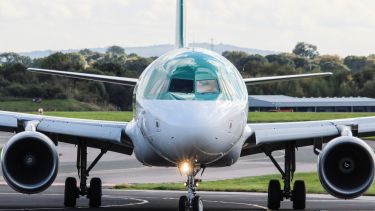Can we fly-less? Understanding people’s attitudes and some policy recommendations
Stephen Allen, Judith Krauss, Renee Timmers and Matt Watson reflect on their Festival of the Mind exhibition.

If commercial aviation were a country, its emissions would be the sixth largest in the world, just behind those of Japan and Germany. Prior to the Covid-19 pandemic, global air traffic was anticipated to grow 4.3 percent annually over the next 20 years. To respond to the climate emergency, radical action is required in relation to air travel to reverse a growth trend and significantly reduce GHG emissions.
Understanding people's attitudes
In our research into exploring how people can fly-less we have developed four different perspectives which express different attitudes to flying-less:
- Disparate - Flying as being economically and socially successful
- Intertwined - Flying as a human right
- Interdependent - Flying to be avoided, but can not often be avoided
- Embedded - Flying as violence to others
Collaborating with Gina Allen, a visual artist, and Kitty Turner, a digital producer and musician, we created an immersive visual-audio exhibition that helps people to consider, reflect upon, and respond to their and others’ attitudes to flying-less. Each of the four perspectives is depicted by a painting, sound-scape and indicative quote of what somebody associating with this perspective would say. There is a podcast which explains the creative approach.
The public exhibition took place as part of an arts festival in Sheffield, in the north of Britain, during September 2022. Visitors to the exhibition were asked to view and listen to the audio-visual, which was presented via a screen and headphones and then respond to feedback questions. The questions included asking visitors about how much they fly, their attitudes to flying-less, and how their views may have changed having seen the exhibition.
Exploring people's attitudes
43 people completed all of the feedback questions. 47% of participants were aged between 18 and 39, 33% between 40 and 59, with the rest over 60 years old. The amount people reported that they fly can be seen in the below graphics.
95% flew economy with 5% business class. The purpose for flying was ‘frequently’ or ‘always’ for holidays for 70% of participants. For work it was ‘never’ the purpose for 72%, with it being ‘frequently’ or ‘always’ for 14%.
People variously associated with the four perspectives on flying-less: Disparate 9%; Intertwined 5%; Interdependent 77%; and, Embedded 9.3%. In response to the central question of ‘Can we fly-less’ the vast majority of participants suggested that we could travel by land, avoid taking (short) holidays abroad, and conduct virtual meetings. Some expressed the challenges that they had experienced when trying to take land travel such as sleeper trains, others the personal benefits of deciding not to fly. Several participants mentioned how unequal the amount of flying was between different people, and that responsibility rested with wealthy people. Those that responded to say flying-less was not possible expressed that work and social needs necessitated more flying.
Developing policy
The aim of the exhibition and indeed this blog post are to stimulate reflection and conversations about flying-less. From the feedback, participants all reflected on their flying, some planning to fly-less, others already not flying much at all, while others felt they were inevitably ‘locked-in’ through the distribution of their family, friends and work across the world. We are presenting the feedback from the exhibition as an indication rather than a comprehensive exploration of attitudes. Although having between us reviewed substantial literature in this area and written about it, particularly in relation to academic conferencing, our findings seem fairly expected: there is significant variation in the amount people fly and their perspective about flying-less, but an overall sense that flying-less is necessary and achievable.
Action on reducing carbon emissions needs to be radical (particularly as technological solutions seem improbable) and so policy also needs to be radical. Attitudes may well vary, but it seems a majority want less flying (particularly longer flights). We suggest:
- From governments we need personal carbon budgets for flying based on a global average viable societal carbon footprint to push flying towards equitable and sustainable levels – the uneven distribution of those who fly a lot (e.g. in UK and US) and those who never or very rarely fly is stark.
- In institutions there is various evidence that the need to fly is overstated for organisational and career success (e.g. in universities). Institutions, particularly in wealthier parts of the world need to make public commitments to reduce greenhouse gas emissions from travel, agree processes for reflecting and deliberating on whether, where and how to travel, and monitor emissions over time. For example, in the university sector various institutions have developed such strategies (see, for example, University of Basel and University of Sheffield) informed by work such as The Tyndall Centre’s model.
Written by Stephen Allen, Judith Krauss, Renee Timmers, and Matt Watson in January 2023.


